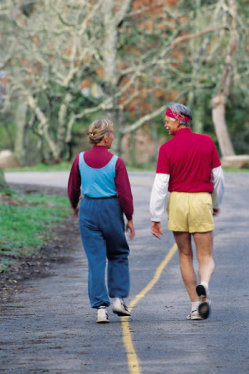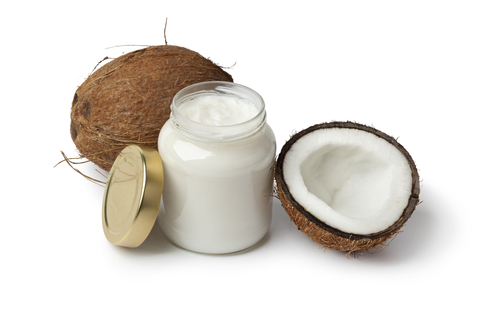Walking for weight loss is one of the easiest and least stressful exercises! It’s a great way for a sedentary person to get moving, and it can also be a very effective, fat-burning, cardio workout! As with any new exercise program, you will want to check with your doctor if you have existing medical conditions that might make exercise dangerous to your health.
Getting started is so easy! All you need is a good pair of walking shoes and some comfortable workout clothes! If it’s cold outside, dress in layers that can be peeled off when necessary! Enjoy the great outdoors and breathe in that fresh air! Walking for weight loss is a nature lover’s favorite activity!
Did You Know?
According to internist, William Meller, walking triggers our bodily systems: digestion, stress relief, thinking and preparation, and sleep! So let's all get up and MOVE!
 If you don’t typically exercise, then getting out the door that very first time is going to be your biggest challenge when walking for weight loss! Don’t let that stop you though, because you can walk quite effectively inside your own home! There are many walking DVDs that can be purchased at bookstores and sports stores, rented at video stores, or even checked out from your local library! Leslie Sansone, for example, has a large collection of fitness walking DVDs that offer a wide range of workouts for beginners or more advanced walkers.
If you don’t typically exercise, then getting out the door that very first time is going to be your biggest challenge when walking for weight loss! Don’t let that stop you though, because you can walk quite effectively inside your own home! There are many walking DVDs that can be purchased at bookstores and sports stores, rented at video stores, or even checked out from your local library! Leslie Sansone, for example, has a large collection of fitness walking DVDs that offer a wide range of workouts for beginners or more advanced walkers.
Walking for weight loss doesn’t have to be a “formal” activity. Buy an inexpensive pedometer and simply aim for 10,000 steps as you move throughout your day! Look for easy ways to increase your steps, such as parking further from your destination, taking the dog for an extra walk each day, or making more trips up and down your stairs. Experts recommend 10,000 steps a day, which is roughly equal to walking 5 miles!
Are you interested in knowing how many calories you burn when walking for weight loss? You can easily burn fat walking by increasing your distance, speed, incline, intensity, adding interval training, and/or adding weights.
Did You Know?
Because walking is a "weight-bearing" activity, older women who walk at least 4 hours a week are 41% less likely to break a hip. (Harvard Medical Center & Brigham and Women's Hospital study)
To Begin..
Always stretch before you begin to loosen your leg and hip muscles. To warm up, walk slowly at first and then work up to a more rapid pace.
As you near the end of your walk, slow your pace for a “cool down.” Some people find it very helpful to stretch again at the end of their walk.
Shin splints are the most common complaint among new walkers. Avoid shin splints by stretching your calf and shin muscles well after each walk. In addition, perform ankle circles and toe points before and after each walk.
Watch your posture! Walk “tall.” Keep your head up and your eyes forward. Your shoulders should be relaxed and held back. Your abdominal muscles and buttocks should be tight. Walk with a natural stride.
For the first two weeks that you walk, stretch before and after for 3 minutes, warm up at a slow pace for 5 minutes, work up to your walking pace for 10 minutes, and slow down to your “cool down” pace for 5 minutes. For more comprehensive information about walking, visit our friends at 50Plus-Fitness-Walking!
Guidelines..
- Goal: General health benefits Walk 30 minutes a day, most days of the week, at a “talking” pace.
- Goal: Improve cardiovascular fitness Walk 3 to 4 days a week, 20 to 30 minutes, at a very fast pace which has you breathing hard but not gasping for air.
- Goal: Weight loss “Power walk” a minimum of five days a week, 45 to 60 minutes, at a brisk pace. A 15-minute mile is considered the “average fitness walking pace.” Walking 4mph, or four, 15-minute miles, burns approximately 500 calories, depending on weight and various other factors.
Benefits of Walking:
- Reduces stress
- Reduces blood pressure and cholesterol
- Reduces risk of heart disease, diabetes, and other medical conditions
- Burns calories
- Slims your waist
- Strengthens back muscles
- Eases stress on joints
- Strengthens your bones
- Improves sleep and mood
- Requires no special equipment
- Can be done anywhere
- Doesn’t cost any money!
Did You Know?
A 2011 report published in Strength and Conditioning Journal reports that the body burns approximately the same amount of fat regardless of whether you eat before or after a workout. The report goes on to state, however, that without proper fuel for the workout, your body may lose muscle, and your calorie-burn will be diminished. This study directly contradicts the myth that exercising on an empty stomach burns more fat, and will come in handy when walking for weight loss.



